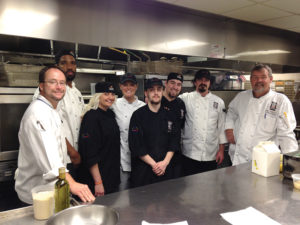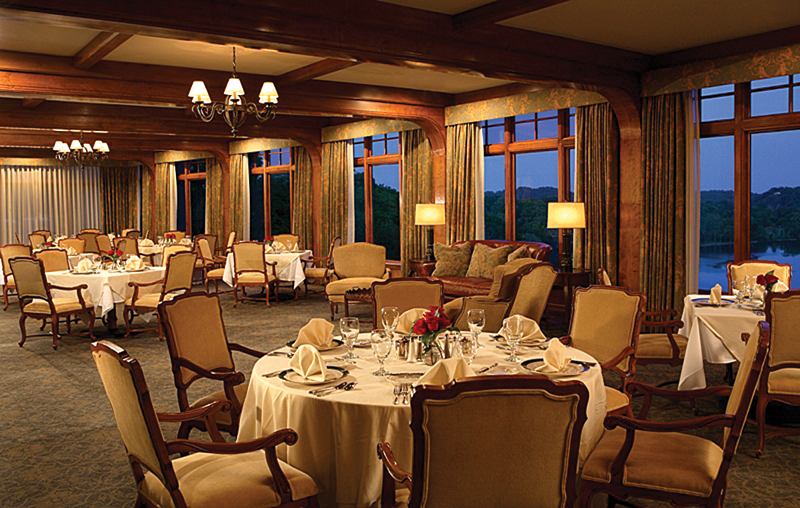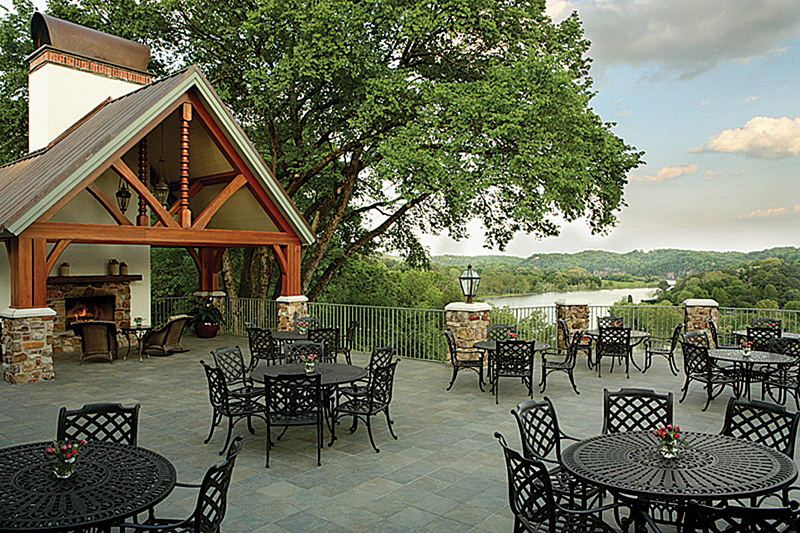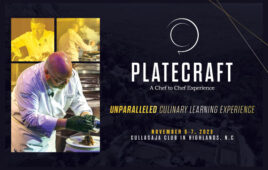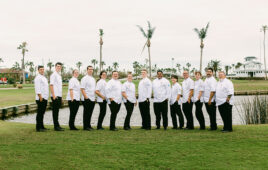David Pinckney, Executive Chef of Knoxville’s Cherokee Country Club, is well on his way to securing the distinction of serving memorable meals to just about everyone in Tennessee’s third-largest city.
David Pinckney is not only one of the most well-known chefs in Knoxville, Tenn., it’s quite possible that no one has cooked for a higher percentage of the 182,000 people in the state’s third-largest city. After becoming a full-fledged “Volunteer” and graduating from the University of Tennessee in Knoxville in 1986, David began his professional career at the city’s premier fine-dining spot, The Orangery, and in 20 years there moved from dishwasher to part-owner, serving as Executive Chef from 1987-2006.
| David Pinckney CHEF PROFILE Current Position: Previous Experience: Education: Professional Affiliations:
|
Then in 2006, David moved to Knoxville’s premier private club, Cherokee Country Club. As Executive Chef at Cherokee, which was founded in 1907 and features a Donald Ross golf course and property with sweeping views of the Tennessee River and Great Smoky Mountains, David and his culinary team have created many memorable dining experiences at Cherokee CC—including ones involving culinary students from the University of Tennessee, whom he was directing for an event at the same time he was answering questions for this interview.
We thank Chef Pinckney for taking the time to share insights into how he’s brought fresh ideas from his restaurant experience to the club side.
Q: Chef, after going from dishwasher to part-owner in 20 years at Knoxville’s finest restaurant, I assume nothing surprised you from an a la carte standpoint after you made the shift to working in clubs. What did you find to be your biggest initial challenges after coming to Cherokee seven years ago?
A: Before I started at Cherokee, everyone told me I would have 800 bosses—and I did not believe them, but it is true to some extent. At Cherokee, there is a large environment of “foodies” with very sophisticated palates, and trying to provide an exceptional dining experience for them every time they come in is the biggest challenge.
Things were going along pretty well until it was time to open this thing called a pool snack shop. It was like opening a new restaurant every year, with a new staff and a new menu. It was a challenge being across the street from the clubhouse, but you had to come up with creative ways to feed a busy pool. We not only provide burgers and fries like any other pool menu, we also offer healthy options and interesting daily specials that keep us very busy.
The golf course snack shop is also across the street, but the same lady has been there for 13 years—although she’s retiring this year, so that will be another interesting challenge.
Q: Tell us about “The Gathering”—your wine dinner concept that has been so successful for you and the membership at Cherokee.
A: “The Gathering” is a club within a club, made up of a very private group of about 12 to 16 couples who wanted to take advantage of The River Room, our formal dining room that overlooks the river. “The Gathering” started about five years ago and they have a dinner every month on either Friday or Saturday night. Cherokee prides itself on good service and we are exceptional at multitasking, which is what we have to do most nights when “The Gathering” is held.
The host couple for “The Gathering” gets to pick the menu, or they let the kitchen pick it for them. The dinner normally consists of six courses with wine pairings picked by the clubhouse and assistant managers and the bar manager—and sometimes I get to help.
What makes “The Gathering” challenging—and fun—is that with each new month, “Mr. and Mrs. Current Host” try to outdo the last couple that had the dinner. This is a great opportunity for the kitchen staff to play with fun and different ingredients.
One month, my old next-door neighbor wanted me to sneak some veal sweetbreads into the dinner they were having. I did sliced veal loin with morel mushroom sauce, but one of the slices of veal was the sweetbread. Everybody loved it!
Q: I am sure your recent wine dinner collaboration with University of Tennessee culinary students was also inspiring for all involved. How was this conceived, and what was the feedback like from the guests?
A: The chef at UT culinary asked me to teach a class for him last year at the university’s Conference Center. Of course the class he picked for me was the Easter Brunch class! Chef Greg and I then started brainstorming about the next session of classes, and we killed two birds with one stone by having the students do an outside event and wine dinner at Cherokee.
The members and guests loved what the students prepared for them and thought it was great that we were working with the local culinary school and letting the students come to Cherokee to do a wine dinner.
For the second dinner, there was a little surprise twist—little did the students know they were prepping for a Board dinner. Then Beth, the student who got her menu chosen for the event, had to go out to the boardroom and talk about the dinner.
Here’s what was prepared for that dinner (click dish name for recipe):
Starter:
Individual Tomato & Goat Cheese Tortes
First course:
Veal Marsala with Mushrooms Marsala Sauce
Truffled & Asparagus Risotto
Vichy Carrots
Second course:
Lamb Chops
Horseradish Whipped Potatoes
Garlic Sautéed Spinach
Dessert:
Raspberry Napoleons with Tangerine Sabayon
Q: Chef, you also cater huge plated meals for the galas and balls hosted at Cherokee. What tips can you offer to those striving for consistency in plating for such large numbers?
A: I think it helps to be very organized and to double-check that you have everything ready early. I have a large staff, and everyone has worked with me for five or more years. I normally have the same person putting the same thing on the plate each time we do an assembly-line plateup.
First thing we do is to plate the salads right before they pre-set them for large parties. At Cherokee we have a separate line for banquets, which keeps the large parties from interfering with the a la carte service. We plate the banquet right before the servers take it out—that keeps it fresher, and the food does not sit in hot boxes for a long period of time.
Q: Working without a pastry chef, you still offer some very upscale desserts at Cherokee. Where does the responsibility lie, and what are some of the most popular seasonal specialties that you turn out during peak season?
A: We no longer have a pastry chef, so the banquet chef and the assistant manager have taken on the task and have been doing a great job. We just changed the dessert menu. The most popular dessert at Cherokee is the K-Town Sundae—a small scoop of vanilla ice cream rolled in pecans and topped with chocolate sauce and caramel, whipped cream and a cherry—all for just $1.50.
Another seasonal dessert we have been doing is a grasshopper pie—but we are using peppermint ice cream instead of mint chocolate chip, on top of an Oreo crust with hot fudge sauce.
Pumpkin bread, grilled on the flat top with sorghum ice cream and caramel sauce and topped with cayenne praline, is another favorite.
Q: Tell us about the live reindeer at your Kids Christmas Party.
A: The reindeer at the Kids Christmas Party was the hit of the year, not only for the kids, but also for the parents, who could not stop taking pictures of them. A local farmer from Rocky Hill, Tenn., less than four miles down the street, brought two reindeer and we set up a pen for them on the terrace overlooking the Tennessee River.
Q: Finally, David, you’re an active member of the Club Managers Association of America. How does this participation benefit you as a club chef?
A: I just recently joined the CMAA, even though I had been going to the state chapter meetings with the managers from my club for years. Being a member gives me a broader view of running a large country club, instead of just foodservice. It also helps me see things from the GM and Board’s perspective. One of the main things they keep stressing is increasing member satisfaction—if you do that, it gives the members more reasons to stay at the club than to quit.
Since I am still fairly new to the club industry, just starting my seventh year at my first club, I think networking with other club managers and chefs is a great way to learn more about the club industry. Being a part of the Volunteer Chapter of Tennessee, we are always going to to different clubs in our region for education and dinners. I enjoy seeing the other clubs and what kind of food they are doing.
Additional recipes:
Filet Rossini
Lobster Crepes



